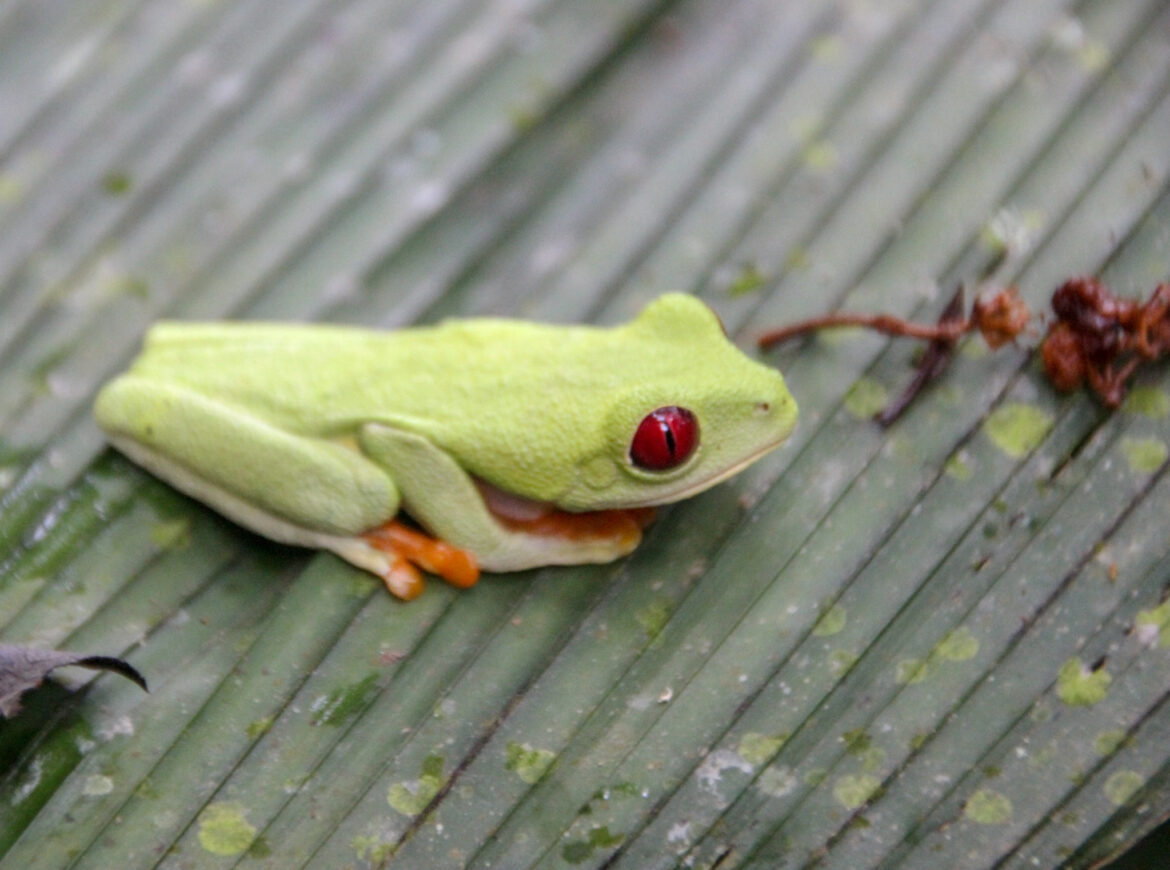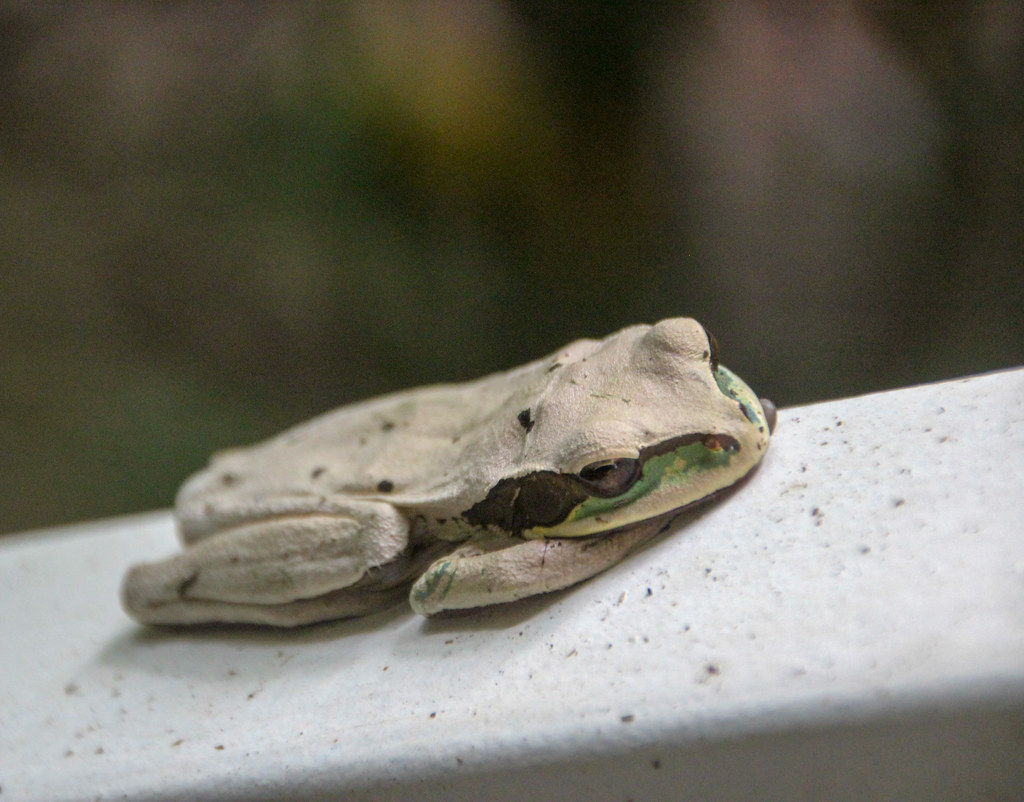Veragua Rainforest offers ecotourism at its best, with a sustainable biodiversity of flora and fauna. Plus, the lush park is home to 52 frog species, the highest number of species in Costa Rica. Their foundation promotes the research of flora and fauna in the 77-hectare (190 acre) tropical rainforest.
They offer public tours, while maintaining partnerships with academic institutions such as the University of Costa Rica. This facilitates publication of findings and sharing them with the world community. They uncovered eleven new animal species at Veragua Rainforest.
Veragua Rainforest is about an hour inland from the Caribbean port, Limon. As an Acupuncturist-at-Sea, I took my day off from my cruise ship in Limon. I enjoyed my day tour here with a good conscience, knowing we contributed to their funds. Along with a Naturalist Guide, we explored a variety of habitats, such as, day & night frogs, butterfly garden, insectarium, serpentarium and research center. Lastly, we took a tram ride through the tree canopy and a small hike to Puma Falls.
Costa Rica’s Veragua Rainforest
Ecotourism & Research
Their first year they found 119 species of amphibians and reptiles with only 2% of the park sampled. This makes Veragua the most frog-diverse place in Costa Rica with 52 species. Some even are among the last natural population only in the park. We learned about 5 areas of frog research: 1) behavior with poison dart frogs 2) aggressive responses in rocket frogs 3) signals of strawberry poison-dart frogs against intrusions 4) conservation project for the tiger frog 5) reproductive ecology of Talamanca glass frog and 6) call of the silent frog Craugastor noblei.
52 Frog Species in Veragua Rainforest
Because of Veragua Rainforest’s high frog diversity, I elaborate on just the species discussed by our Naturalist Guide. The golden poison dart frog is Earth’s most toxic frog species, with enough poison (carried in skin cells) to kill 20,000 mice and a human in 3 minutes. They’re named Poison Dart Frogs because the natives used the frogs’ toxic secretions from their skin on blow darts. The dart frog comes in 15-30 different colors, telling predators that it is toxic.
Strawberry Dart Frog
Earth’s Most Toxic Frog Species
I was intrigued to see the strawberry species with its bright red body and bluish legs. This was such a surprise, as I was unaware of them and how small they are, less than an 1/2 inch. Later, I noticed the frog’s eggs lined up under a leaf nearby. I also delighted in seeing a red-eyed tree frog, camouflaged in daylight still on a leaf.
The month before I had seen one with its big red eyes open standing on its red legs. In this camouflaged position, its red legs were tucked underneath the body with green eyelids covering the red, blending with the big tropical leaf that it sat on. How adorable it looked in its secrecy. These frogs are not poisonous, and their big red eyes are a defense mechanism, to startle and scare off predators.
It was awesome to see the red-eyed and dart frog in the open space of their natural habitat. The other frogs were inside the nocturnal habitat in glass cages. The funny irony the glass frog stuck to the glass wall. These frogs have translucent skin to camouflage, so you can see inside their organs. They recently discovered a new species of the glass frog in the Talamanca Mountains.
Frogs as the “Canary in the coal mine”
Important to mention is the alarming number of frog species that are going extinct. Many environmentalists refer to the frogs as the “Canary in the coal mine.” They explicitly mark the harm put upon the health of our planet. Amphibians have existed on Earth for over 300 million years. Approximately 200 frog species have become extinct in the last 20 years. In comparison, just 1 species became extinct every 250 years in the past. Understanding how amphibians interplay in the web of life helps to sustain the biodiversity of our natural world.
Even though this park has 343 bird species, we did not witness many birds.
Mainly because, the best time for birding is early in the morning, and we were there in the afternoon. Although, we did see an empty Oriole nest. I learned about a fascinating global event called the “Christmas Bird Count (CBC). This monitors birds for 24 hours in a 12-km diameter area to count species.
Costa Rica’s Veragua Rainforest & Butterfly Garden
Inside the butterfly garden we got to see a sampling of the 175 species in Costa Rica. I was so caught up in trying to get a good photo of the Blue Morpho Butterflies dancing around, that I hardly noticed the others.
My success in catching their blue fluttering wings on camera was unsuccessful; however, I did et ag good shot of one with its wings shut, displaying the outer brownish, camouflaged design with numerous eye spots. In comparison, we also saw the owl butterfly, which looks similar to the outer wings of the Blue Morpho. It displays an owl-like eyespot as a defense mechanism to predators.
We visited the Insectarium, where I glossed over it, as insects are not my top interest among the diversified paradise in the rainforest. Also, we visited the snakes displayed in their glass cages, of which I glossed over as well. Whenever anything goes behind any kind of cage, I lose interest. Seeing the flora and fauna in its natural habitat is always preferred, unless of course it is for safety reasons. I did find a tree snake outside, weaving in and out of branches. Naively, I got caught up in taking photos getting quite close without knowing what kind it was or if it was poisonous. It was long and thin, slithering with a raised head that seemed to pull the tail end.
Tram and Puma Falls
After exploring the flora and fauna, we went on a tram down the mountain through the tree canopy and hiked to Puma Falls, humbly nestled in a canyon, with a beautiful teal blue pool of resting waters overflowing into shimmering falls below…Then we returned up the mountain on the tram through the rainforest with the lush, green wilderness all around us. It was so peaceful looking into the distance at the refreshing view of trees in all directions.
Read Next!
Costa Rica’s Jaguar Rescue Center with Sloths, Monkeys, Birds & other Wildlife
Amazing La Fortuna – The Epicenter of Costa Rican Wellness Travel
Roatan Island Beaches & Jungle – A Honduras Paradise









